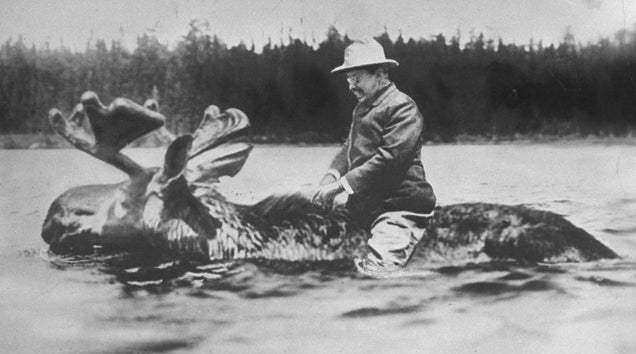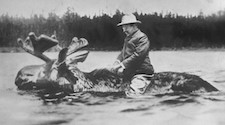Adrienne LaFrance and Matt Novak live in different cities and write for different sites in the Gawker Media network. LaFrance is a freelancer who contributes to several other publications. Novak works full-time on his blog, Paleofuture, which is part of Gizmodo.
She often writes about tech and media. He writes about past visions of the future.
Despite the differences, LaFrance and Novak recently converged on the same idea: debunking hoaxes and misinformation as a regular feature.
LaFrance writes the Antiviral column for Gawker, which carries the headline “Here’s What’s Bullshit on the Internet This Week.” She identifies trending misinformation and new hoaxes and digs into them to reveal what’s fake.
Novak’s debunking effort, which appears roughly monthly, focuses on calling out fake images. He particularly likes debunking images from the many historical pictures accounts that sprouted up on Twitter, unleashing a stream of fake, Photoshopped and unattributed images claiming to be from the past.
 Both efforts began at the end of last year, just before Charlie Warzel of BuzzFeed declared that 2014 would be the “Year Of The Viral Debunk.” Soon after that post appeared published, Paulo Ordoveza, who I previously profiled, decided to set up his @PicPedant account. It calls out fake and unattributed images on Twitter.
Both efforts began at the end of last year, just before Charlie Warzel of BuzzFeed declared that 2014 would be the “Year Of The Viral Debunk.” Soon after that post appeared published, Paulo Ordoveza, who I previously profiled, decided to set up his @PicPedant account. It calls out fake and unattributed images on Twitter.
Aside from the two Gawker Media features and the Twitter image debunkers, The Washington Post now has its own “What was fake on the Internet this week” feature by writer Caitlin Dewey, which appears on the Post culture blog. It launched in March.
As of now, Warzel’s prediction looks prophetic in that we’ve seen the emergence of consistent debunking efforts that are picking up steam in 2014. These new debunkers also speak to how debunking can be integrated to a wide range of efforts, from highly specialized blogs and Twitter accounts to large traditional new organizations and edgier digital efforts.
Making it consistently viral, however, will take more work…
Debunking as a reporting lens
LaFrance pitched the Antiviral column to John Cook, then Gawker’s editor, because she saw it in part as an opportunity to tell stories that others miss. Novak debunks because it helps expose the tendency for people to glorify or condemn the past at the expense of truth.
Both apply a level of reporting and research to their work. After all, nobody wants an unreliable debunker.
“My goal is always to have reporting behind it because it’s very easy to Google the hoax and aggregate what people have already done,” LaFrance said. “I’d much rather go deeper. One reason so much gets shared is people not taking time to put out a call or do the emailing back and forth with PR people — and we need to do that.”
LaFrance and Novak are using debunking as a lens to discover the true story behind a fake thing. That’s one of the promises of adopting the debunker’s lens — you reveal the things other people missed.
“Just saying something is fake isn’t as interesting as saying where it came from,” LaFrance said.
For Novak, debunking is also way to pursue a defining narrative of his blog.
“I decided to do the first post because my specialty is past visions of the future,” he said. “I tend to look at a lot of aspirational images … I think it’s interesting to look at how we can both romanticize the past and also judge it so harshly. I think that both are strains of when you see people passing around things from historical picture accounts on Twitter. It’s often, ‘Oh look at how awful things were’ or about how much better were.”
I asked him what the viral, fake image of Teddy Roosevelt riding a moose in deep water represented for people.

“I think that speaks to the great man myth of history we want so desperately to believe,” he said. “It’s about, ‘Look at how much more badass masculine our leaders used to be.’ ”
This is one thing to recognize about manufactured fakes and hoaxes: they often, though not always, are an attempt to expose something about society, to express a point of view or emotion, to get a reaction.
Real-time debunking
During breaking news situations and disasters, however, rumors and misinformation spread in part because of the tremendous uncertainly and sense of danger. People pass things along because the information seems urgent and important.
In that moment, all of us have an innate desire to share what we are seeing as a way to make sense of what’s happening. That gives rise to another type of debunking, where speed is needed to match the flow of false information.
Hurricane Sandy was an important moment for real-time debunking. Efforts at BuzzFeed, The Atlantic and the “Is Twitter Wrong?” Tumblr from U.K. journalist Tom Phillips came to the forefront.

A debunked image, from The Atlantic.
When Sandy hit, Phillips was working as international editor for MSN U.K. (He now works for BuzzFeed U.K.) He decided to test whether it would be possible to deliver real-time debunking, using a Tumblr and Twitter account.
“Part of the reason I did it in the first place was as an experiment to see if it was possible,” Phillips told me when we spoke by phone last year. “You know, would that fit into sort of a daily workflow in a newsroom, in that kind of context, or would it just become a massive, massive time suck? And the answer from that was basically yeah, you can do it. You can do an awful lot of it in a way that actually fits in with a daily workflow pretty well.”
Phillips said he’s seen debunking become more a part of breaking news coverage. By the time of the Boston bombings and Sandy Hook shootings, he said, “I saw an awful lot of journalists were actively going out doing debunking. Debunking is now part of reporting, basically.”
It’s become a regular part of his work, too. Earlier this year he produced a very BuzzFeed post, “14 Incredible But Fake Viral Images — And The Twitter Account Debunking The Picspammers.”
In a bit of debunking inception, the story called out fake images as a way to introduce people to @PicPedant.
But is it viral?
Nick Denton, the head of Gawker Media wrote in a memo to staff last year that, “the crowd will eventually choose the juicy truth over a heartwarming hoax.”
It was something of an endorsement of debunking. But he’s also expressed skepticism about the virality of debunking:
@SladeHV @thestalwart Debunking doesn’t often go viral. Nobody likes open questions. But they love answers e.g. truth about Manti Teo.
— Nick Denton (@nicknotned) February 6, 2014
There can be home runs from debunking. Deadspin’s Manti Te’o story, published more than a year ago, is approaching 4.5 million views. Novak said his photo debunkings have done major traffic for Gizmodo, with one post garnering more than 700,000 views. LaFrance’s Antiviral column broke 100,00 views on the first attempt, but hasn’t done that again since.
Phillips told me that, “I think you’ll find that [debunking] can be, you know, it can actually be as popular and as viral as the untrue stuff.”
To truly get there, we’ll need to more journalists and others bringing different perspectives and applying different approaches to debunking. Tint the debunking lens in new ways. We’ll need to take lessons from the creators of viral fakes and from viral wizards like Upworthy, and to think about ways to get people to accept the truth rather than the lie.
For now, to get better debunking, we need more debunking.







Comments